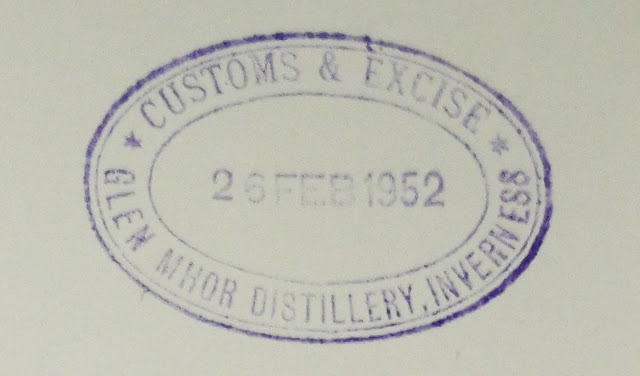Glen Mhor Logbook 26th February 1952
The years are flying by as we reach 1952 for our ongoing Glen Mhor logbook exploration. And this is the first noted sight of potential pilfering or at least a test of the system at the distillery. As the only logbook we have unearthed, commences from 1936, we cannot say for sure that theft didn't exist prior, i.e. 1894-1936, although we know John Birnie was feared by the distillery team and ruled with a fair but firm approach.
It's great to add more context to the missing years on our timeline (albeit probably the most detailed timeline of any distillery, now) with the only prior 1952 entry being a newspaper article from William Birnie.
We'll jump into the transcription before debating what it reveals and how we can take a couple of things from the entry.
'The Surveyor
Inverness 2nd District
58 High Street
Inverness
Sir
I have to report that during the weekly examination of casks in Warehouse 3 at this distillery today, the cooper found that a hole had been bored through the gauge and shutter protecting one of the windows looking onto the nursery. The casks against the window had not been touched.
The hole was approximately 3/4" in diameter and has been repaired by means of patches of gauge and wood. I am satisfied as to its security.
???, Officer'
Today, 58 High Street, Inverness, is part of the major shopping street in Inverness and plays host to an optician. I do know that through time, controls at the individual distilleries in the city were merged into one convenient office. The individual site offices were phased out, controls were relinquished and set officers became a thing of the past. We're inadvertently tracking these changes that result in what we see at distilleries today.
It'll be something to note such changes in future entries and any addresses as we slowly close in on modern practices and ad hoc Excisemen recording these entries, which seems to be happening in 1952 with another officer (signature not recognised) penning this entry.
 |
| Photo credit: Microsoft Bing |
Moving on, we can consider where the warehouse was and potentially which one was number 3. I've mentioned before in my Distilleries of Great Britain deep-dive article, why I believe that Glen Mhor is noted to have 9 warehouses. In fact, I mention the extension of the original warehouse which is the culprit as to why any aerial photograph of Glen Mhor shows 8 warehouses. We have previously published this lost extension from 1895 in a prior article and this helped formed the largest warehouse on the site.
Logically, you would number each warehouse as it was built, after all, you might never now how many a distillery would end up with over time. The mention of the nursery is also of interest as the surrounding land was a nursery, as shown in this map from 1929 shows:
You can see that the boundaries for the Muirtown nursery do not reach Glen Mhor, in fact as shown by further maps in our Map Section from 1938, most of the nursery area has started to become residential housing. However this still leaves the land behind the football ground stand and down to the area labelled Muirtown Locks. My understanding is that this was allotments and still for plants, so the nursery comment makes sense in this regard. It also confirms that the warehousing was in numerical order.
Using this local knowledge and planning records, we can confirm that warehouse #3 was as below in this image (ignoring the 2 newer warehouses that didn't arrive until the 1960s) from the mid-1980s:
So, the window of interest in this entry is in the top corner of the site and is very inaccessible with the football ground forming a natural barrier almost along the whole line of warehouses. In fact, only numbers 2 and 3 will have been potentially accessible from the more urban land that surrounded the southern end of the site in the 1950s.
Our photo archive being what it is, we can even pluck an image of the warehouses (in this case numbers 2-4) from the 1950s, which gives us the situation and window that the Exciseman was referring to i.e. the middle one in this image:
Zooming in even further than above, we can see the potential issue as the warehouse window falls just outside of the football boundary during this decade, with the fence, tree and hedge forming a barrier that falls just to the right of the window. Meaning you could access it without venturing into the stadium.
Although one of the biggest memories - other than who was testing illegal access into a warehouse - was what a cooper was doing to find the issue. Perhaps checking casks inside the warehousing and, by chance, noticed the issue. As I cannot see why he would be on the other site, on 3rd party ground.
I showed this entry to Alan Winchester for his thoughts on the situation and added insight:




Comments
Post a Comment